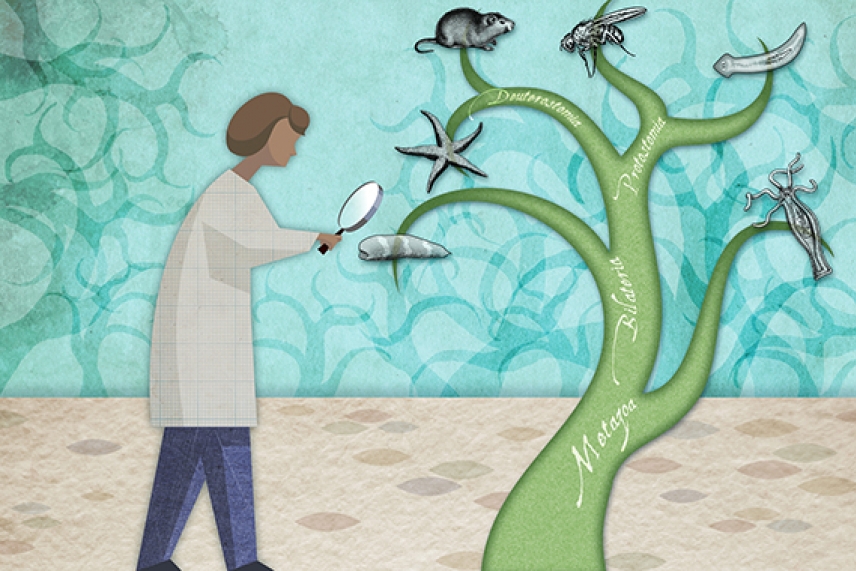
Steven Lee/Whitehead Institute
Small worm muscles up to reveal ancient body patterning mechanism during regeneration
We usually think of muscle for its contractile ability, helping starfish envelop their prey, gazelles leap across the savanna, and people lift their first cup of coffee. Researchers are now learning that in addition to muscle’s contractile abilities, it may also have an ancient and widespread body patterning function in regenerative organisms.
Peter Reddien, Whitehead Institute Member, investigator with Howard Hughes Medical Institute, and a professor of biology at Massachusetts Institute of Technology and colleagues have been using planarians, freshwater flatworms, as a model for understanding regeneration. Reddien and colleagues had discovered that planaria uses signals from the muscle to guide regeneration, but they knew that planaria are just one "branch of a branch" of the Bilateria, all of the bilaterally symmetric animals. Was the use of muscle in signaling positional information just a quirk specific to this small branch on the giant tree of life, or could it reflect more general principles? To address this question, Reddien and colleagues turned to the acoel (a-seal), a small regenerative marine worm auspiciously located on the evolutionary tree as an outgroup to all the rest of the Bilateria, or what’s known as a sister branch. The last common ancestor of planarians and acoels is therefore the last common ancestor of all bilaterally symmetric animals including humans. This is important because similarities found between acoels and planaria can then be inferred to also be common to this ancient ancestor.
In a recent Nature Communications paper, Reddien, along with first author graduate student Amelie Raz, reveal that the acoel, which is separated from planaria by over 550M years of evolution, also uses muscle as the source of instructive signals for regeneration, suggesting that this role for muscle is a conserved feature present in the regenerative common ancestor of all Bilateria.
Reddien and others had previously shown that factors called Positional Control Genes (PCGs), which include members of the Wnt and Bmp signaling pathways, are expressed in the planarian’s muscle cells and provide instructional positional information during regeneration. Disrupting the expression of PCGs using RNA interference techniques during regeneration causes patterning defects along the anterior-posterior axis, such as a head growing where a tail should be, or a tail in place of a head. In order to understand whether what they were learning was unique to planarians or reflected more fundamental, generalizable principles of development, Raz and Reddien seized upon the acoel Hofstenia miamia.
Seeing the potential of the acoel to help address important evolutionary questions, Reddien and his lab had established Hofstenia as a model system and shown that disrupting PCGs in the acoel disrupted body patterning in regeneration as it did in planaria. Raz and Reddien wanted to understand if, like planaria, the signals for body patterning also came from the muscle. The researchers developed a new technique to ask whether Hofstenia PCG expression was in muscle cells, looking at co-localization of PCGs with the muscle markers tropomyosin or titin-like, and determined that the PCGs in acoels, like planaria, were expressed almost exclusively in muscle cells and further uncovered that most muscle, almost 90%, express at least one PCG. They also looked in cell types other than muscle and noted the absence of PCGs and found that PCG expression in muscle cells is quickly turned on in regions after amputation. These findings suggesting that a major function of muscle in acoels, like in planaria, is to serve as the source of instructive positional information for instructing regeneration. The studies also highlight the value of using evolutionarily distant outgroups to understand fundamental principles in biology.
* * *
Peter Reddien’s primary affiliation is with Whitehead Institute for Biomedical Research, where his laboratory is located and all his research is conducted. He is also a Howard Hughes Medical Institute Investigator and a Professor of Biology at the Massachusetts Institute of Technology.
* * *
Acoel regeneration mechanisms indicate an ancient role for muscle in regenerative patterning. Nature Communications. October 30, 2017. DOI 10.1038/s41467-017-01148-5. Amelie A. Raz (1), Mansi Srivastava (2), Ranja Salvamoser (1,3), Peter W. Reddien (1).
1. Howard Hughes Medical Institute, MIT Biology, Whitehead Institute for Biomedical Research, 9 Cambridge Center, Cambridge MA 02142, USA
2. Department of Organismic and Evolutionary Biology, Harvard University, Cambridge MA, 02138, USA
3. Current address: Walter and Eliza Hall Institute of Medical Research, Parkville, VIC, 3052, Australia
Contact
Communications and Public Affairs
Phone: 617-452-4630
Email: newsroom@wi.mit.edu


